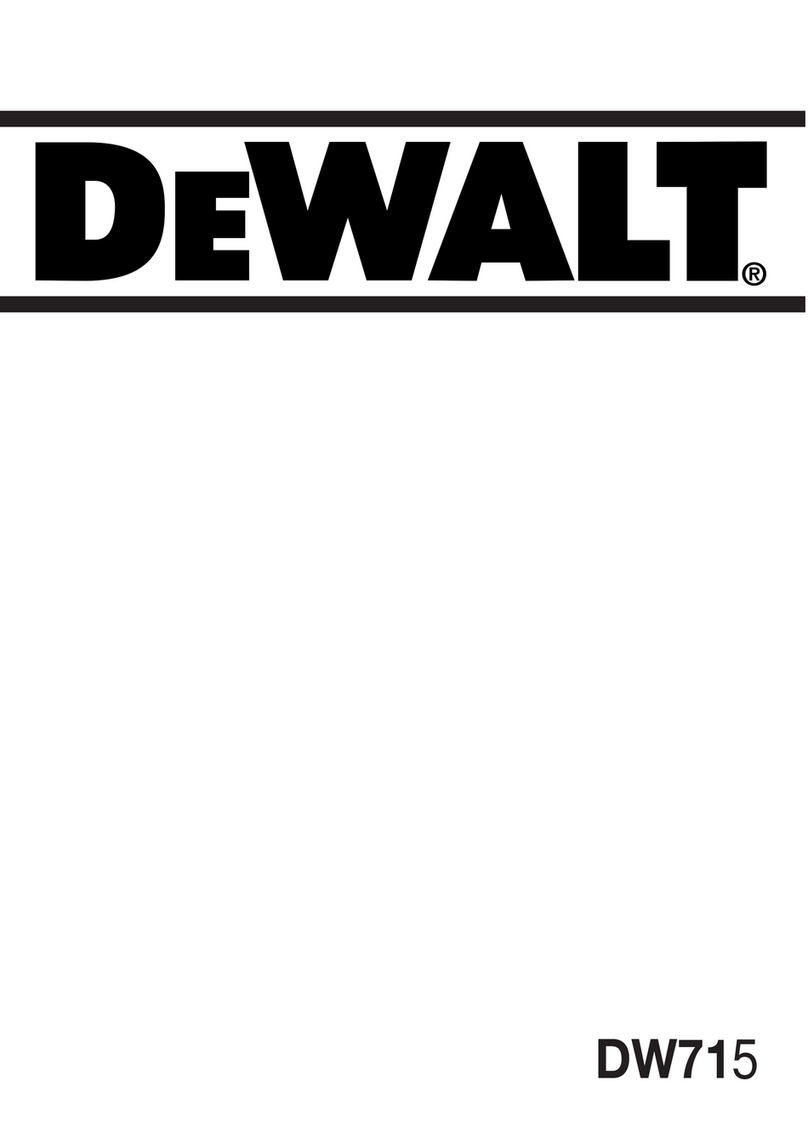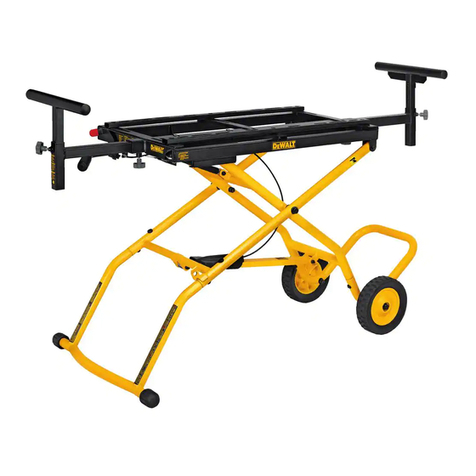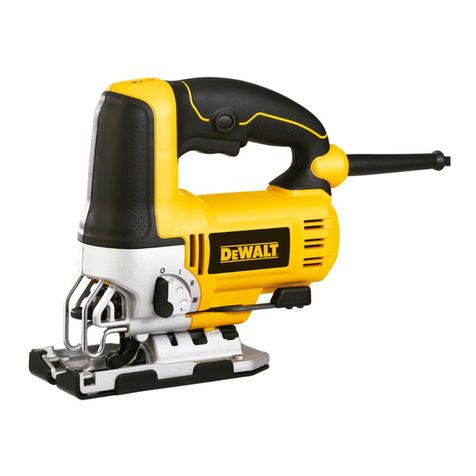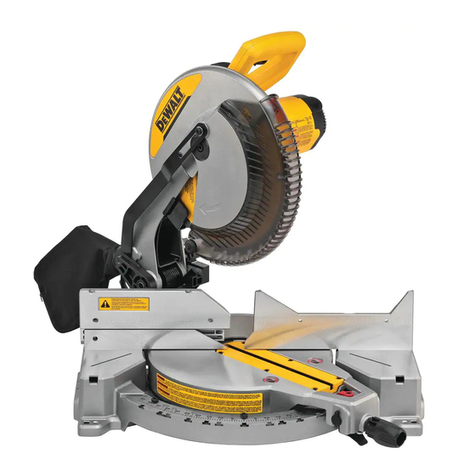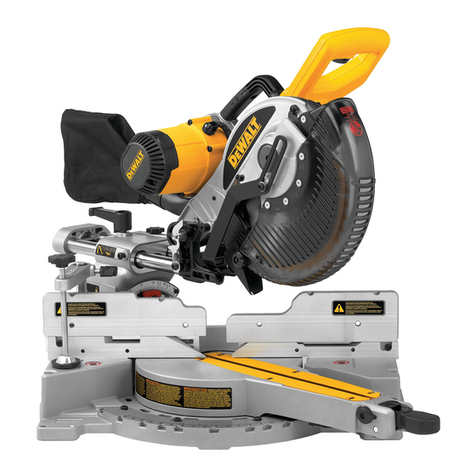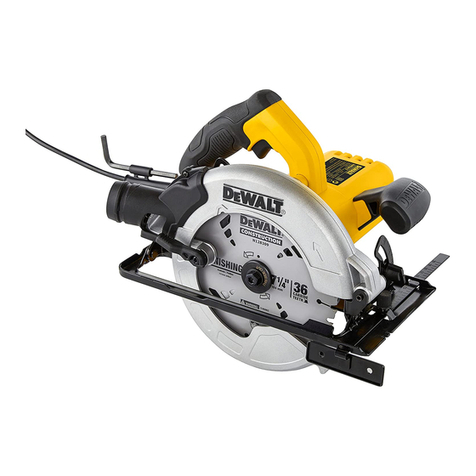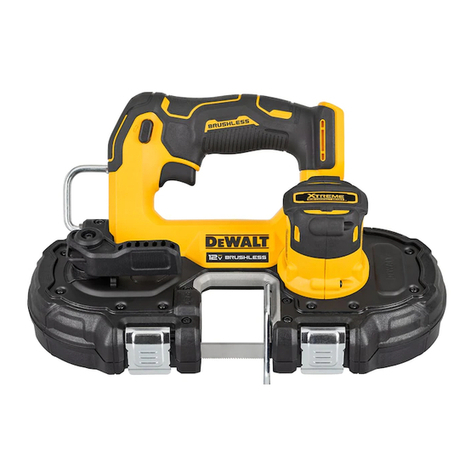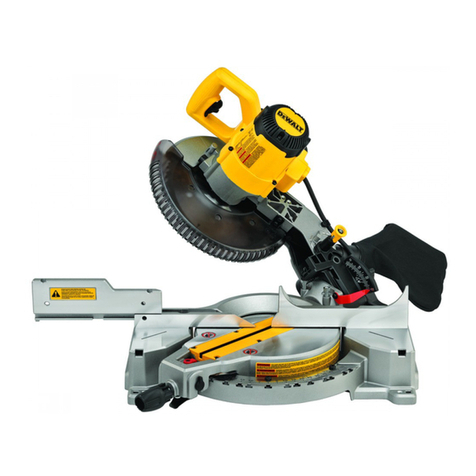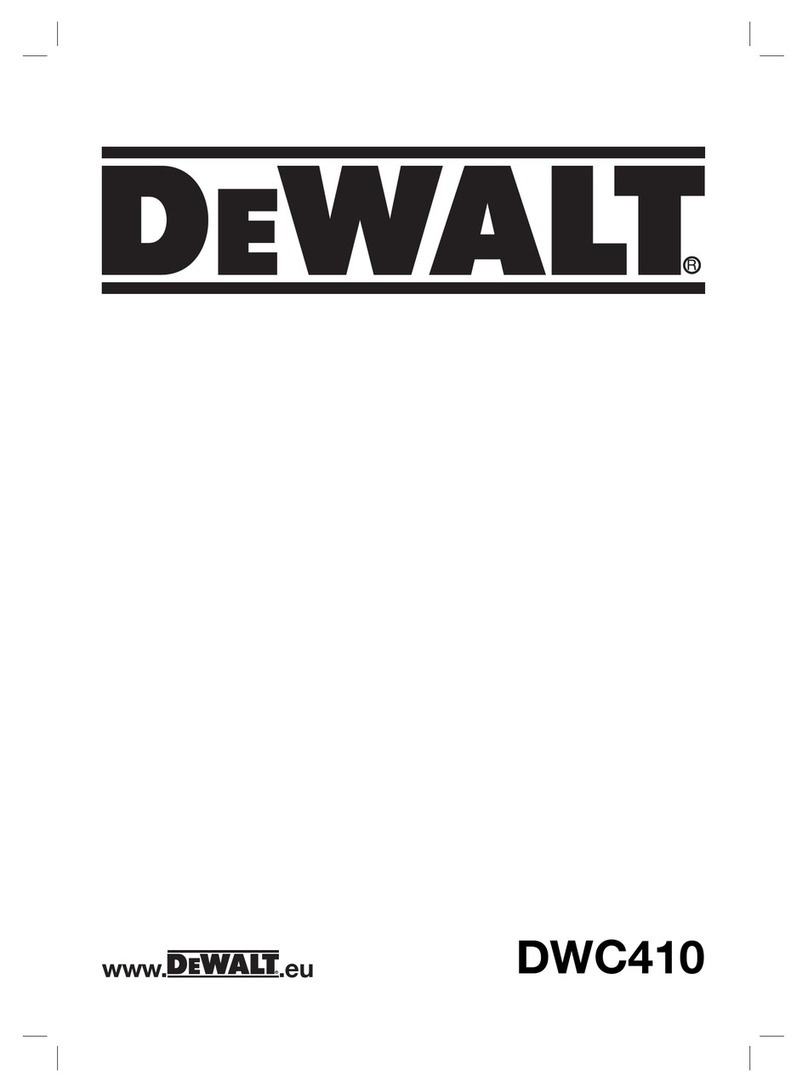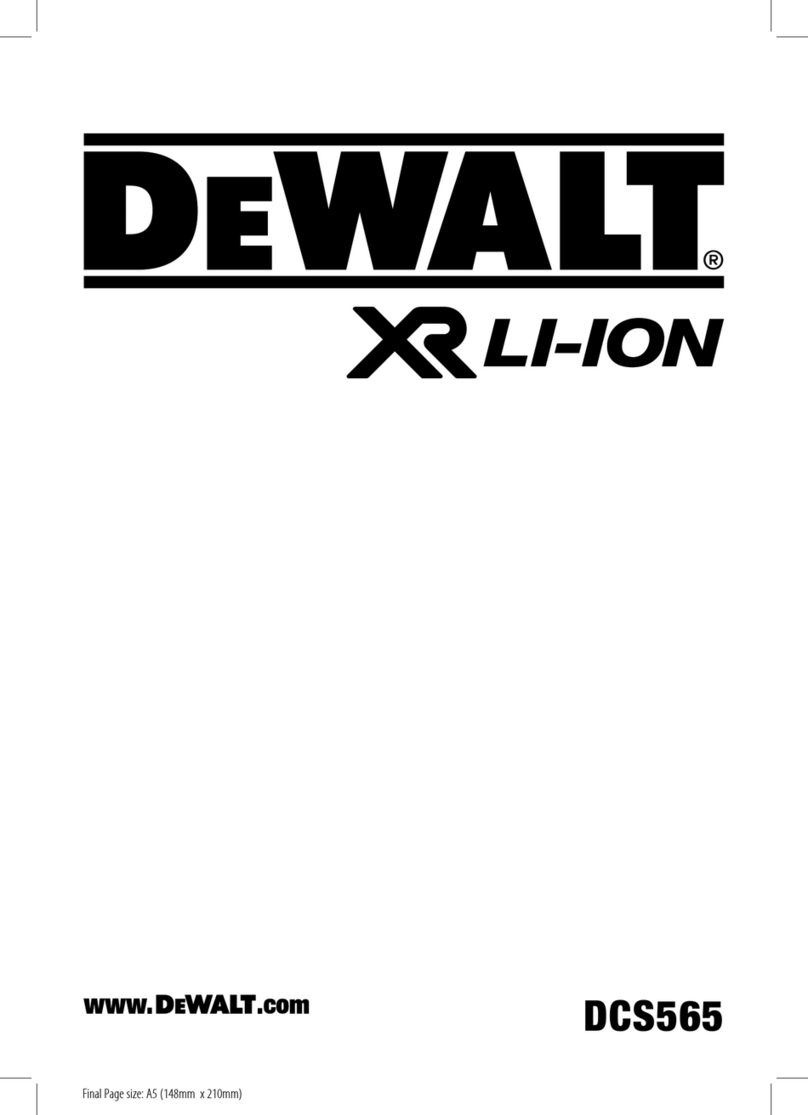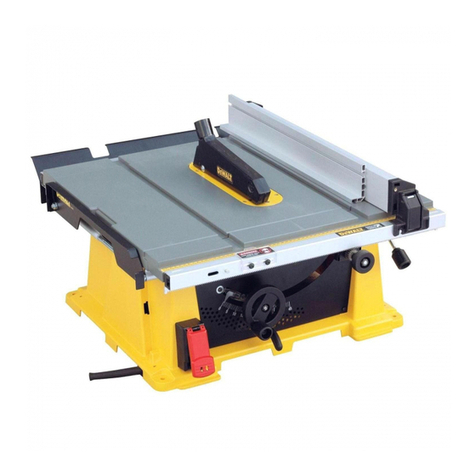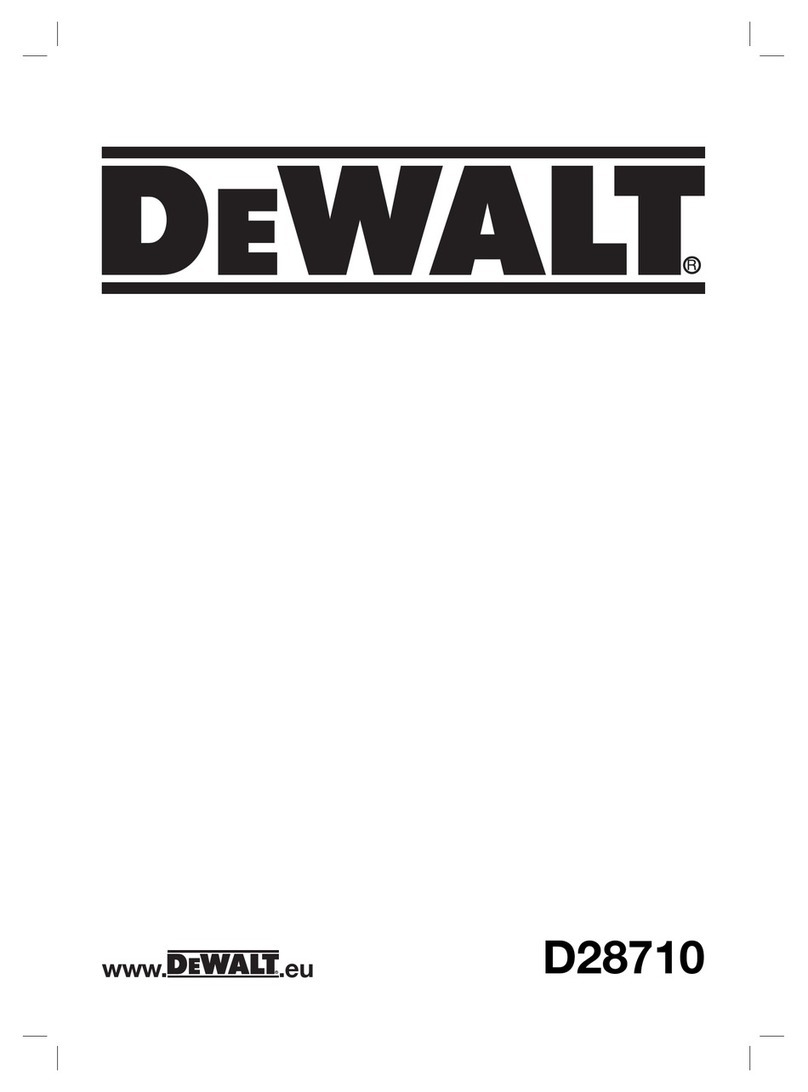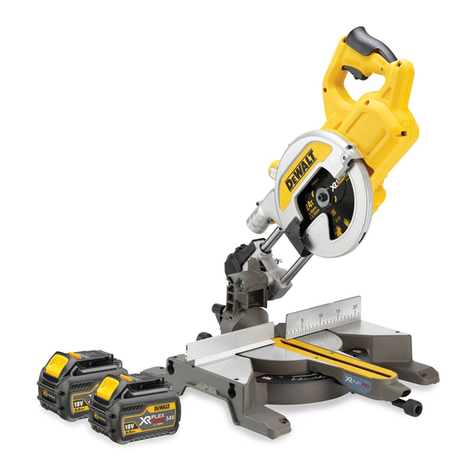
3
ENGLISH
“ON” and with no workpiece on the table, move the saw blade through a complete simulated cut
to assure there will be no interference or danger of cutting thefence.
• Provide adequate support such as table extensions, saw horses, etc. for a workpiece
that is wider or longer than the table top. Workpieces longer or wider than the miter saw
table can tip if not securely supported. If the cut-off piece or workpiece tips, it can lift the lower
guard or be thrown by the spinningblade.
• Do not use another person as a substitute for a table extension or as additional
support. Unstable support for the workpiece can cause the blade to bind or the workpiece to
shift during the cutting operation pulling you and the helper into the spinningblade.
• The cut-off piece must not be jammed or pressed by any means against the spinning
saw blade. If confined, i.e. using length stops, the cut-off piece could get wedged against the
blade and thrownviolently.
• Always use a clamp or a fixture designed to properly support round material such as
rods or tubing. Rods have a tendency to roll while being cut, causing the blade to “bite” and pull
the work with your hand into theblade.
• Let the blade reach full speed before contacting the workpiece. This will reduce the risk of
the workpiece beingthrown.
• If the workpiece or blade becomes jammed, turn the miter saw off. Wait for all moving
parts to stop and disconnect the plug from the power source and/or remove the battery
pack. Then work to free the jammed material. Continued sawing with a jammed workpiece
could cause loss of control or damage to the mitersaw.
• After finishing the cut, release the switch, hold the saw head down and wait for the
blade to stop before removing the cut-off piece. Reaching with your hand near the coasting
blade isdangerous.
• Hold the handle firmly when making an incomplete cut or when releasing the switch
before the saw head is completely in the down position. The braking action of the saw may
cause the saw head to be suddenly pulled downward, causing a risk ofinjury.
Additional Safety Rules for Miter Saws
WARNING: Do not insert the battery into the unit until complete instructions are read
andunderstood.
• NEVER PLACE HANDS CLOSER THAN 4" (100 mm) FROM THE BLADE.
• DO NOT OPERATE THIS MACHINE until it is completely assembled and installed according to
the instructions. A machine incorrectly assembled can cause seriousinjury.
• OBTAIN ADVICE from your supervisor, instructor, or another qualified person if you are not
thoroughly familiar with the operation of this machine. Knowledge issafety.
• FOLLOW ALL WIRING CODES and recommended electrical connections to prevent shock
or electrocution. Protect electric supply line with at least a 15 ampere time-delay fuse or a
circuitbreaker.
• MAKE CERTAIN the blade rotates in the correct direction. The teeth on the blade should point in
the direction of rotation as marked on thesaw.
• TIGHTEN ALL CLAMP HANDLES, knobs and levers prior to operation. Loose clamps can cause
parts or the workpiece to be thrown at highspeeds.
• BE SURE all blade and blade clamps are clean, recessed sides of blade clamps are against blade
and arbor screw is tightened securely. Loose or improper blade clamping may result in damage
to the saw and possible personalinjury.
• DO NOT OPERATE ON ANYTHING OTHER THAN THE DESIGNATED VOLTAGE for the saw.
Overheating, damage to the tool and personal injury mayoccur.
• DO NOT WEDGE ANYTHING AGAINST THE FAN to hold the motor shaft. Damage to tool and
possible personal injury mayoccur.
• NEVER CUT METALS or masonry. Either of these can cause the carbide tips to fly off the blade at
high speeds causing seriousinjury.
• NEVER HAVE ANY PART OF YOUR BODY IN LINE WITH THE PATH OF THE SAW BLADE.
Personal injury willoccur.
• NEVER APPLY BLADE LUBRICANT TO A RUNNING BLADE. Applying lubricant could cause
your hand to move into the blade resulting in seriousinjury.
• DO NOT place either hand in the blade area when the saw is connected to the power source.
Inadvertent blade activation may result in seriousinjury.
• NEVER REACH AROUND OR BEHIND THE SAW BLADE. A blade can cause seriousinjury.
• DO NOT REACH UNDERNEATH THE SAW unless it is unplugged and turned off. Contact with
saw blade may cause personalinjury.
• SECURE THE MACHINE TO A STABLE SUPPORTING SURFACE. Vibration can possibly cause
the machine to slide, walk, or tip over, causing seriousinjury.
• USE ONLY CROSSCUT SAW BLADES recommended for miter saws. For best results, do not
use carbide tipped blades with hook angles in excess of 7 degrees. Do not use blades with deep
gullets. These can deflect and contact the guard, and can cause damage to the machine and/or
seriousinjury.
• USE ONLY BLADES OF THE CORRECT SIZE AND TYPE specified for this tool to prevent
damage to the machine and/or seriousinjury.
• INSPECT BLADE FOR CRACKS or other damage prior to operation. A cracked or damaged
blade can come apart and pieces can be thrown at high speeds, causing serious injury. Replace
cracked or damaged bladesimmediately.
• CLEAN THE BLADE AND BLADE CLAMPS prior to operation. Cleaning the blade and blade
clamps allows you to check for any damage to the blade or blade clamps. A cracked or damaged
blade or blade clamp can come apart and pieces can be thrown at high speeds, causing
seriousinjury.
• DO NOT USE WARPED BLADES. Check to see if the blade runs true and is free from vibration. A
vibrating blade can cause damage to the machine and/or seriousinjury.
• DO NOT use lubricants or cleaners (particularly spray or aerosol) in the vicinity of the plastic
guard. The polycarbonate material used in the guard is subject to attack by certainchemicals.
• KEEP GUARD IN PLACE and in workingorder.
• ALWAYS USE THE KERF PLATE AND REPLACE THIS PLATE WHEN DAMAGED. Small chip
accumulation under the saw may interfere with the saw blade or may cause instability of
workpiece whencutting.
• USE ONLY BLADE CLAMPS SPECIFIED FOR THIS TOOL to prevent damage to the machine
and/or seriousinjury.
• CLEAN THE MOTOR AIR SLOTS of chips and sawdust. Clogged motor air slots can cause the
machine to overheat, damaging the machine and possibly causing a short which could cause
seriousinjury.
• NEVER LOCK THE SWITCH IN THE “ON” POSITION. Severe personal injury mayresult.
• NEVER STAND ON TOOL. Serious injury could occur if the tool is tipped or if the cutting tool is
unintentionallycontacted.
• ADDITIONAL INFORMATION regarding the safe and proper operation of power tools (i.e., a
safety video) is available from the Power Tool Institute, 1300 Sumner Avenue, Cleveland, OH
44115-2851 (www.powertoolinstitute.com). Information is also available from the National
Safety Council, 1121 Spring Lake Drive, Itasca, IL 60143-3201. Please refer to the American
National Standards Institute ANSI 01.1 Safety Requirements for Woodworking Machines and the
U.S. Department of Labor OSHA 1910.213Regulations.
WARNING: Cutting plastics, sap coated wood, and other materials may cause melted
material to accumulate on the blade tips and the body of the saw blade, increasing the risk
of blade overheating and binding whilecutting.
WARNING: ALWAYS use safety glasses. Everyday eyeglasses are NOT safety glasses.
Also use face or dust mask if cutting operation is dusty. ALWAYS WEAR CERTIFIED
SAFETYEQUIPMENT:
• ANSI Z87.1 eye protection (CAN/CSA Z94.3),
• ANSI S12.6 (S3.19) hearing protection,
• NIOSH/OSHA/MSHA respiratoryprotection.
WARNING: Some dust created by power sanding, sawing, grinding, drilling, and other
construction activities contains chemicals known to the State of California to cause cancer,
birth defects or other reproductive harm. Some examples of these chemicalsare:
• lead from lead-based paints,
• crystalline silica from bricks and cement and other masonry products, and
• arsenic and chromium from chemically-treatedlumber.
Your risk from these exposures varies, depending on how often you do this type of work. To reduce
your exposure to these chemicals: work in a well ventilated area, and work with approved safety
equipment, such as those dust masks that are specially designed to filter out microscopicparticles.
• Avoid prolonged contact with dust from power sanding, sawing, grinding, drilling, and
other construction activities. Wear protective clothing and wash exposed areas with
soap and water. Allowing dust to get into your mouth, eyes, or lay on the skin may promote
absorption of harmfulchemicals.
WARNING: Use of this tool can generate and/or disperse dust, which may cause serious
and permanent respiratory or other injury. Always use NIOSH/OSHA approved respiratory
protection appropriate for the dust exposure. Direct particles away from face andbody.
WARNING: Always wear proper personal hearing protection that conforms to ANSI
S12.6 (S3.19) during use. Under some conditions and duration of use, noise from this
product may contribute to hearingloss.
CAUTION: When not in use, place tool on its side on a stable surface where it will not
cause a tripping or falling hazard. Some tools with large battery packs will stand upright
on the battery pack but may be easily knockedover.
• Air vents often cover moving parts and should be avoided. Loose clothes, jewelry or long
hair can be caught in movingparts.
The label on your tool may include the following symbols. The symbols and their definitions are
asfollows:
V.........................volts
Hz .......................hertz
min.....................minutes
or DC......direct current
......................Class I Construction (grounded)
…/min..............per minute
BPM....................beats per minute
IPM.....................impacts per minute
RPM....................revolutions per minute
sfpm ...................surface feet per minute
SPM....................strokes per minute
A.........................amperes
W........................watts
or AC........... alternating current
or AC/DC....alternating or direct current
......................Class II Construction (double insulated)
no.......................no load speed
n.........................rated speed
......................earthing terminal
.....................safety alert symbol
.....................visible radiation
.....................wear respiratory protection
.....................wear eye protection
.....................wear hearing protection
.....................read all documentation

